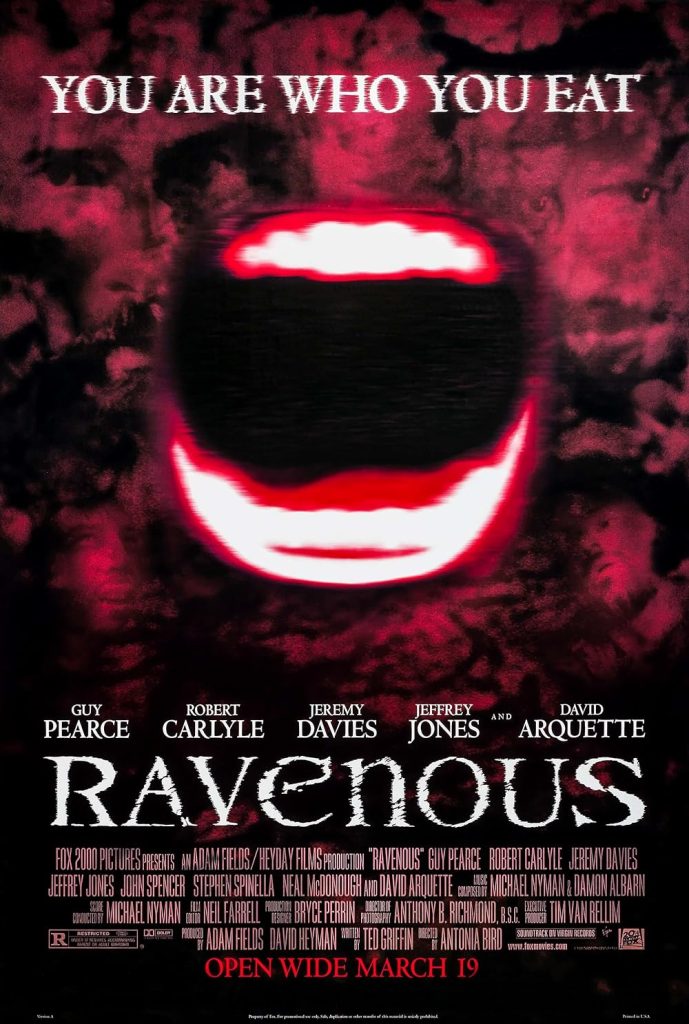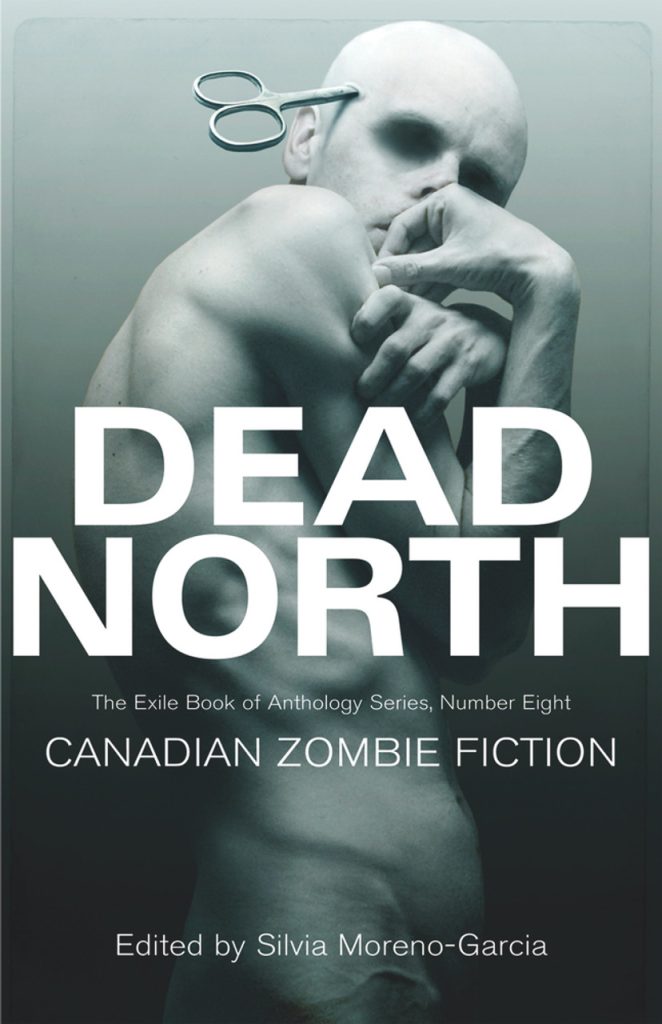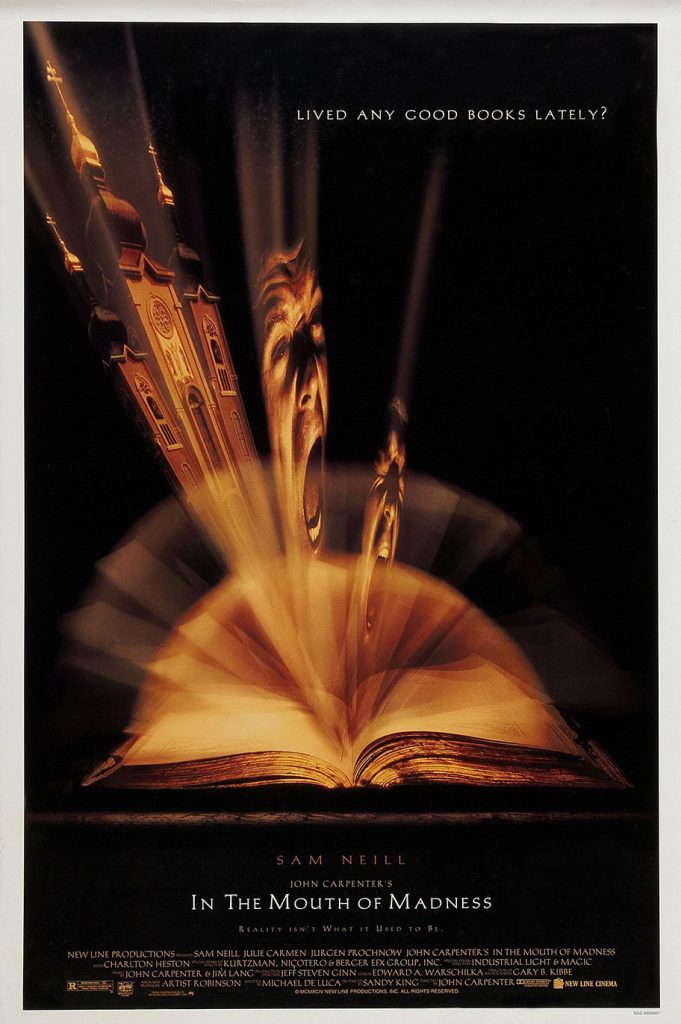Ravenous
By Olivia Shan

Antonia Bird’s Ravenous is a great, unsung classic of late ‘90s horror that is well overdue for a good reconsidering by the larger horror fanbase. Set during the Mexican-American war of 1846, Second Lieutenant John Boyd (Guy Pearce) is exiled to a remote military base on the Western Frontier as a reprimand for his cowardice. His new garrison encounters a ragged, shady stranger, Colqhoun (Robert Carlyle), who warns them of a certain Colonel Ives, who has —Colqhoun alleges— murdered and cannibalised the remainder of his fellow travel-partners. Lieutenant Boyd is on the case.
Homoeroticism meets adventure epic meets Western meets black comedy… This gory, low-budget movie has so much to enjoy. Considering that Antonia Bird was hired as director extremely late in the production, it’s truly remarkable just how cohesive the film feels; from its sparkling cast of idiosyncratic characters to how every frame teems with equal measures of wit and chaos, every aspect has a purpose. The whole is tied up with an arresting soundtrack by Michael Nyman that shares the film’s satirical, infectious energy. Not a minute of screen time is wasted, and every bit of it is pure, exhilarating, skin-crawling fun.
Despite its boisterous nature, the film also offers a striking indictment of Manifest Destiny and American imperialism. Ravenous takes inspiration from Algonquian mythology, and its inclusion of Martha, an Indigenous scout played by Native American actress Sheila Tousey, is a vital element that provides a nuanced Indigenous perspective in a story filled with blatantly racist white settlers. In Ravenous’ world, cannibalism is a sickened representation of an America that greedily exploits Indigenous cultures and lands, which ironically ends up cannibalising itself.
It’s perhaps precisely because of how assertively weird and niche this film is that Warner Brothers had no idea how to properly market it to mass audiences, leading to a less-than-adequate showing at the box office. But a small and fervent fan following has since unearthed it and now confidently places it among its much more appropriately lauded contemporaries —perhaps, after a viewing, you’ll count yourself among them as well?
Fresh Dirt from the Grave
Par Magdalena Nitchi

« Fresh Dirt from the Grave », la traduction anglaise du dernier recueil de nouvelles de Giovanna Rivero, est finalement sortie cette année. Pour tous les fans d’horreur gothique ou de littérature latino-américaine, cette collection est une lecture parfaite. Le talent de Rivero pour la narration est incroyable et la traductrice Isabel Adey a fait un excellent travail pour transmettre les sentiments de mystère et de peur saturant la collection.
Rivero s’appuie sur de nombreux motifs gothiques traditionnels pour cette collection, y compris l’histoire classique d’un marin devenu fou en mer et l’histoire d’une adolescente maltraitée par un prêtre, mais j’ai trouvé que l’œuvre la plus intéressante était « Kindred Deer ». Suivant le point de vue d’une narratrice anonyme et de son mari Joaquín, Rivero explore l’éthique des essais de développement des drogues sur les humains. Après son inscription comme sujet de test, Joaquín se transforme essentiellement en vampire ; son alimentation est limitée et il doit éviter à tout prix de s’exposer au soleil. Il commence à changer et plusieurs aspects de la vie conjugale doivent aussi se transformer. Le comble des problèmes est un cerf mort sur leur propriété, duquel ni lui, ni sa femme peuvent se débarrasser aisément.
Cette histoire ne rentre pas tout à fait dans les catégories de la science-fiction ou de l’horreur surnaturelle, mais contient suffisamment d’éléments des deux pour amener le lecteur à se demander ce qui se passe. Qu’est-ce que l’entreprise obscure espère tirer de ces tests ? Quel est le vrai effet de la drogue sur Joaquín ? Après une série de moments étranges, le lecteur se demande si le narrateur perd la tête ou si Joaquín perd la raison. Comme toute bonne histoire gothique, le lecteur est aspiré par le mystère, et je ne gâcherai pas les révélations qui vous attendent à la fin de l’histoire.
Giovanna Rivero se taille progressivement une place dans le monde des écrivains latino-américains, notamment avec plusieurs livres et nouvelles qui plongent dans la science-fiction et l’horreur. Sa prose riche et sa façon de construire les mondes des histoires ajoutent un niveau vraisemblable de réalisme, alors que les éléments gothiques poussent ses lecteurs à mettre en question la réalité. « Fresh Dirt from the Grave » est une merveilleuse collection qui laisse le lecteur charmé, et j’espère qu’elle sera traduite dans de nombreuses autres langues.
Dead North: Canadian Zombie Fiction

Dead North: Canadian Zombie Fiction is a wonderfully curated collection that delivers exactly what it promises: 20 excellent short stories centred around the undead. Edited by the iconic Silvia Moreno-Garcia, the collection has everything from traditional apocalypse stories to a silly romp about undead cows devastating Montreal.
While there are quite a few gems in this collection, my favourite stories were probably “Those Beneath the Bog” and “The Food Truck of the Zombie Apocalypse.” In the former, Jacques L. Condor (also known as Maka Tai Meh) builds on traditional Meskwaki/First Nations mythology for a hair-raising horror story. Rather than using the tired ‘ancient Indian burial ground’ trope, Condor builds on the idea of restless dead; after a battle between two tribes, those who are improperly buried come to haunt a bog near a remote lake. When a small group of Indigenous hunters disregard the warning of one of their elders and hunt for moose there, they are left scrambling for their lives against ravenous spirits who will eat anything, leaving behind only bones. This looming sense of doom is masterfully established early on in the story, and its conclusion will give the reader ample reason to fear bogs.
Despite its lighthearted title, “The Food Truck of the Zombie Apocalypse” is actually a somewhat tragic but hopeful story. Beth Wodzinski tells the story of an elderly poutine truck driver determined not to give up on her and her husband’s dream, even after she loses him to the “Z” virus. When she sees an American hitchhiking along the snowy road, she knows that she has to pick him up before he succumbs to the cold, and risk seeing whether he is infected. In only a few pages, Wodzinski deftly explores survivor’s guilt, the paranoia instilled by living in an apocalypse, and the heartache of losing a loved one. Yet hope remains in spite of it all, as fellow survivors help one another.
As the nights continue to get longer and colder, there is nothing better than curling up with a scary book. Dead North is not only a good read for this Halloween, it is perfect for the winter season as well. With the various zombie varieties and subgenres of post-apocalyptic fiction explored in this anthology, there will surely be something for everyone to enjoy.
In the Mouth of Madness
By Fred Azaredo

John Carpenter has long been one of my all-time favourite directors, but I’ve always found it puzzling how little recognition he gets from self-declared Serious Film Buffs. The undisputed horror classics like Halloween and The Thing are justly celebrated, but lesser-known works like In the Mouth of Madness generally only receive praise in ‘cult’ circles. Indeed, critics at the time derided it as overcomplicated even as they slammed it for not really exploring the possibilities of its premise. It’s amazing how wrong they were on both counts—this is the rare film that manages to balance incredible gross-out effects with intensely disturbing Lovecraftian horror.
In fact, I’d argue this is a movie well ahead of its time in many ways. For all the talk of the “prestige horror” revival of the ‘90s with films like Misery and Jacob’s Ladder, intelligent scares were few and far between back then—audiences still by and large preferred slashers and creature features. These crowd-pleasers may have been self-aware (see Deep Blue Sea’s infamous—and spoilery!—Samuel L. Jackson scene), but hardly psychologically nuanced. Carpenter’s movie scrupulously follows every step of hapless insurance investigator John Trent’s descent into madness, making the audience feel like they’re falling right along with him. Sam Neill’s incredibly committed performance definitely helps, too—surely one of the finest lead turns in a horror film.
Though the name ‘Lovecraft’ is never mentioned, Mouth also deserves credit as one of the first—and best—evocations of the author’s trademark style. Sure, Lovecraft is critically oversaturated now, but back in 1994, all we really had were Stuart Gordon’s cult classics Re-Animator and From Beyond and a few undistinguished B-movies. The HBO shows, Cthulhu memes and dubious children’s films were yet to come. And it’s not just notable for being pioneering; the filmmakers’ reverence for the author is evident everywhere here. From the title itself (a play on “At the Mountains of Madness”) to the New England town at the center of the story’s mystery (a fusion of Innsmouth, Dunwich, and their ilk) to the author who acts as the main antagonist (an outrageous gestalt of Lovecraft himself and Stephen King), this film oozes Lovecraft from every tentacled orifice. So, if you’re still looking for a spooky and clever treat this Halloween, give this one a whirl. I promise you (probably) won’t get sucked into a parallel eldritch dimension of eternal torment.
